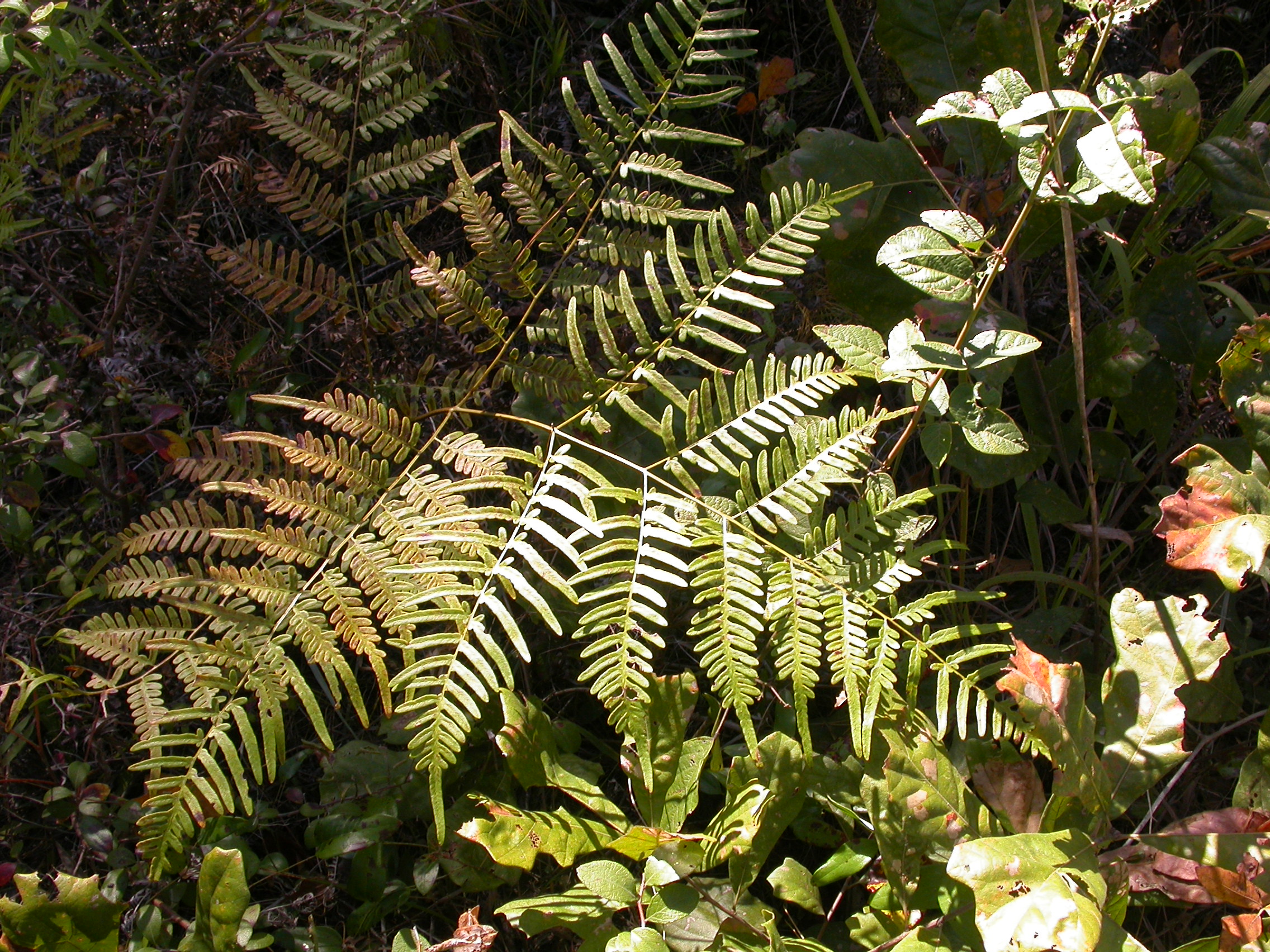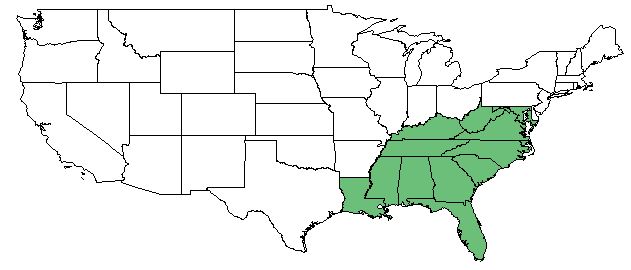Difference between revisions of "Pteridium latiusculum"
Rwagner914 (talk | contribs) (Created page with "{{subst:Template:PlantName}}") |
HaleighJoM (talk | contribs) (→Ecology) |
||
| (20 intermediate revisions by 5 users not shown) | |||
| Line 1: | Line 1: | ||
{{italic title}} | {{italic title}} | ||
| + | Common names: western brackenfern | ||
<!-- Get the taxonomy information from the NRCS Plants database --> | <!-- Get the taxonomy information from the NRCS Plants database --> | ||
{{taxobox | {{taxobox | ||
| − | | name = | + | | name = Pteridium latiusculum |
| − | | image = | + | | image = Pteridium_latiusculum_KMR.jpg |
| − | | image_caption = Photo by | + | | image_caption = Photo by Kevin Robertson |
| regnum = Plantae | | regnum = Plantae | ||
| − | | divisio = | + | | divisio = Pteridophyta |
| − | | classis = | + | | classis = Filicopsida |
| − | | ordo = | + | | ordo = Polypodiales |
| − | | familia = | + | | familia = Dennstaedtiaceae |
| − | | genus = '' | + | | genus = ''Pteridium latiusculum'' |
| − | | species = ''''' | + | | species = '''''P. latiusculum''''' |
| − | | binomial = '' | + | | binomial = ''Pteridium latiusculum'' |
| − | | binomial_authority = | + | | binomial_authority = (Desvaux) Hieronymus |
| − | | range_map = | + | | range_map = PTER_LATI_DIST.JPG |
| − | | range_map_caption = Natural range of '' | + | | range_map_caption = Natural range of ''Pteridium latiusculim'' from Weakley. <ref>Weakley, Alan S. 2015. Flora of the Southern and Mid-Atlantic States: Working Draft of 21 May 2015. University of North Carolina, Chapel Hill, North Carolina. 1320 pp. </ref> |
}} | }} | ||
==Taxonomic Notes== | ==Taxonomic Notes== | ||
| + | Subspecies: ''Pteridium aquilinum'' (L.) Kuhn ssp. ''latiusculum'' | ||
| + | |||
| + | Varieties: ''Pteridium latiusculum'' (Desvaux) Hieronymus ex Fries var. ''latiusculum'', ''Pteridium latiusculum'' (Desvaux) Hieronymus ex Fries var. ''pseudocaudatum'' (Clute) Maxon, ''Pteris latiuscula'' Desvaux var. ''latiuscula'' | ||
| + | |||
==Description== | ==Description== | ||
<!-- Basic life history facts such as annual/perrenial, monoecious/dioecious, root morphology, seed type, etc. --> | <!-- Basic life history facts such as annual/perrenial, monoecious/dioecious, root morphology, seed type, etc. --> | ||
| + | ''P. latiusculum'' is a native perennial forb that is a member of the ''Dennstaedtiaceae'' family.<ref name= "USDA"> USDA Plants Database URL: https://plants.usda.gov/core/profile?symbol=PTAQL </ref> | ||
| + | It has short rootstalks that run horizontally up to a meter. The stalks are terminated by the leaf fronds that are broadly triangular in shape. The plants spread by spores or by the branching rootstalks.<ref> Mueschner, W.C. 1957. Poisonous Plants of the United States. The Macmillan Company, New York.</ref> | ||
| + | |||
==Distribution== | ==Distribution== | ||
| + | The species is native to the southeast United States gulf coastal plain region, ranging from Louisiana and Kentucky to Maryland.<ref name= "USDA"/> | ||
| + | |||
==Ecology== | ==Ecology== | ||
===Habitat=== <!--Natural communities, human disturbed habitats, topography, hydrology, soils, light, fire regime requirements for removal of competition, etc.--> | ===Habitat=== <!--Natural communities, human disturbed habitats, topography, hydrology, soils, light, fire regime requirements for removal of competition, etc.--> | ||
| + | The species is naturally found in dry woodlands, forests, and heath balds, up to 1600 meters in elevation.<ref name= "Weakley"> Weakley, A. S. (2015). Flora of the Southern and Mid-Atlantic States. Chapel Hill, NC, University of North Carolina Herbarium. </ref> It prefers dry, sandy or gravelly soils, and as a result is often found in abandoned fields and pastures.<ref> Mueschner, W.C. 1957. Poisonous Plants of the United States. The Macmillan Company, New York.</ref> | ||
<!--===Phenology===--> <!--Timing off flowering, fruiting, seed dispersal, and environmental triggers. Cite PanFlora website if appropriate: http://www.gilnelson.com/PanFlora/ --> | <!--===Phenology===--> <!--Timing off flowering, fruiting, seed dispersal, and environmental triggers. Cite PanFlora website if appropriate: http://www.gilnelson.com/PanFlora/ --> | ||
<!--===Seed dispersal===--> | <!--===Seed dispersal===--> | ||
<!--===Seed bank and germination===--> | <!--===Seed bank and germination===--> | ||
| − | + | ||
| − | <!--===Pollination===--> | + | ===Fire ecology=== <!--Fire tolerance, fire dependence, adaptive fire responses--> |
| − | + | Populations of ''Pteridium latiusculum'' have been known to persist through repeated annual burning.<ref>Platt, W.J., R. Carter, G. Nelson, W. Baker, S. Hermann, J. Kane, L. Anderson, M. Smith, K. Robertson. 2021. Unpublished species list of Wade Tract old-growth longleaf pine savanna, Thomasville, Georgia.</ref> | |
| + | |||
| + | <!--===Pollination===--> | ||
| + | ===Herbivory and toxicology===<!--Common herbivores, granivory, insect hosting, poisonous chemicals, allelopathy, etc--> | ||
| + | Wild hogs will dig up and eat the roots of the ferns, but the plant is poisonous in large amounts to most other livestock.<ref> Mueschner, W.C. 1957. Poisonous Plants of the United States. The Macmillan Company, New York.</ref> | ||
<!--==Diseases and parasites==--> | <!--==Diseases and parasites==--> | ||
| − | ==Conservation and | + | ==Conservation, cultivation, and restoration== |
| + | |||
| + | ==Cultural use== | ||
| + | If harvested when immature, the shoots can be prepared as a green much like asparagus.<ref> Mueschner, W.C. 1957. Poisonous Plants of the United States. The Macmillan Company, New York.</ref> | ||
| − | |||
==Photo Gallery== | ==Photo Gallery== | ||
<gallery widths=180px> | <gallery widths=180px> | ||
</gallery> | </gallery> | ||
==References and notes== | ==References and notes== | ||
Latest revision as of 14:31, 15 July 2022
Common names: western brackenfern
| Pteridium latiusculum | |
|---|---|

| |
| Photo by Kevin Robertson | |
| Scientific classification | |
| Kingdom: | Plantae |
| Division: | Pteridophyta |
| Class: | Filicopsida |
| Order: | Polypodiales |
| Family: | Dennstaedtiaceae |
| Genus: | Pteridium latiusculum |
| Species: | P. latiusculum |
| Binomial name | |
| Pteridium latiusculum (Desvaux) Hieronymus | |

| |
| Natural range of Pteridium latiusculim from Weakley. [1] | |
Contents
Taxonomic Notes
Subspecies: Pteridium aquilinum (L.) Kuhn ssp. latiusculum
Varieties: Pteridium latiusculum (Desvaux) Hieronymus ex Fries var. latiusculum, Pteridium latiusculum (Desvaux) Hieronymus ex Fries var. pseudocaudatum (Clute) Maxon, Pteris latiuscula Desvaux var. latiuscula
Description
P. latiusculum is a native perennial forb that is a member of the Dennstaedtiaceae family.[2] It has short rootstalks that run horizontally up to a meter. The stalks are terminated by the leaf fronds that are broadly triangular in shape. The plants spread by spores or by the branching rootstalks.[3]
Distribution
The species is native to the southeast United States gulf coastal plain region, ranging from Louisiana and Kentucky to Maryland.[2]
Ecology
Habitat
The species is naturally found in dry woodlands, forests, and heath balds, up to 1600 meters in elevation.[4] It prefers dry, sandy or gravelly soils, and as a result is often found in abandoned fields and pastures.[5]
Fire ecology
Populations of Pteridium latiusculum have been known to persist through repeated annual burning.[6]
Herbivory and toxicology
Wild hogs will dig up and eat the roots of the ferns, but the plant is poisonous in large amounts to most other livestock.[7]
Conservation, cultivation, and restoration
Cultural use
If harvested when immature, the shoots can be prepared as a green much like asparagus.[8]
Photo Gallery
References and notes
- ↑ Weakley, Alan S. 2015. Flora of the Southern and Mid-Atlantic States: Working Draft of 21 May 2015. University of North Carolina, Chapel Hill, North Carolina. 1320 pp.
- ↑ 2.0 2.1 USDA Plants Database URL: https://plants.usda.gov/core/profile?symbol=PTAQL
- ↑ Mueschner, W.C. 1957. Poisonous Plants of the United States. The Macmillan Company, New York.
- ↑ Weakley, A. S. (2015). Flora of the Southern and Mid-Atlantic States. Chapel Hill, NC, University of North Carolina Herbarium.
- ↑ Mueschner, W.C. 1957. Poisonous Plants of the United States. The Macmillan Company, New York.
- ↑ Platt, W.J., R. Carter, G. Nelson, W. Baker, S. Hermann, J. Kane, L. Anderson, M. Smith, K. Robertson. 2021. Unpublished species list of Wade Tract old-growth longleaf pine savanna, Thomasville, Georgia.
- ↑ Mueschner, W.C. 1957. Poisonous Plants of the United States. The Macmillan Company, New York.
- ↑ Mueschner, W.C. 1957. Poisonous Plants of the United States. The Macmillan Company, New York.